Metal Sculptures
The making of the entrance sign for Carcross
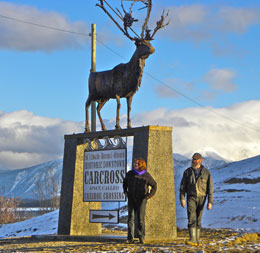 |
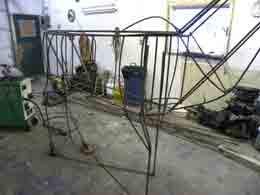 |
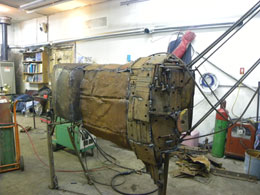 |
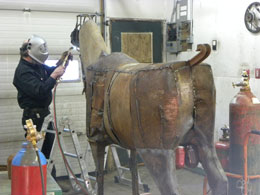 |
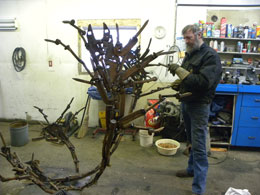 |
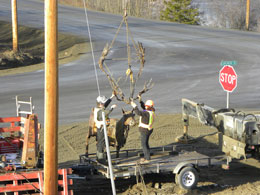 |
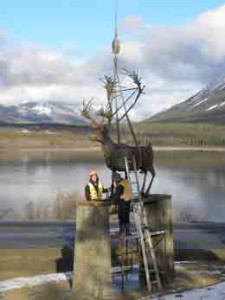 |
In the fall of 2009 the competition for the entrance sign for Carcross came up. It was part of the waterfront beautification projects that were funded jointly by the Federal and Territorial governments. The process was a little different from others in that once the various ideas were submitted and passed the initial criteria inspection, they were to be presented by the artists at a public meeting in Carcross, and the people there would vote on which one they wanted. I am happy to say I was chosen to do the sign.
My idea for the Carcross sign involved a larger than life size sculpture of a bull caribou welded from principally recycled railroad spikes, plates, and other metal that has been discarded by the WP & YR. This sculpture is mounted between two reinforced concrete pillars that are 8′ tall. The welcome sign to Carcross is mounted below the caribou. Top Image © Douglas Hnatiuk >
The idea behind the caribou relates back to the origin of the town’s name, “Caribou Crossing”, and the historic importance of this area to the first Nation people, – hunting and drying meat.
One of the main reasons why a town settlement grew at this place is largely due to the WP & YR which provided steady employment for a number of
families, both through the train and the stern-wheelers. WP & YR is still a significant “player” in Carcross today and it is for this reason that I chose to fabricate the caribou from their recycled metal. I had been given permission to do this by the president of WP & YR.
By combining the railroad spikes with the image of a caribou two significant symbols behind Carcross’ origins are melded. Below the caribou above the printed sign are abstract waves cut out of sheet metal to support the idea of caribous crossing water.
This was the first project that Roger and I had ever done together, as well as my first large 3D sculpture. I went several times to MacBride museum to take pictures, measurements and sketches of their mounted caribou. We were able to use Don Noble’s workshop to create the caribou which was completed and then stored in Roger’s yard until we were able to install it in Carcross October 2010.
In creating the caribou, Roger and I learned a lot about the process of creating an art sculpture together. It was a very different process than Roger was used to working on normal jobs. Art requires a lot of standing back, looking, reassessing and making adjustments, where Roger was used to getting a blue print and figuring out the fastest most efficient way of doing it. Through it all, we learned to trust each others ability and area of expertise, and started to forge a good working relationship.
There is one story that maybe notes sharing here. It probably was a pivotal moment that changed our working relationship for the better.
One day, we had worked rather hard on the forelegs. I needed a break to be able to study what we had done. It was during this break that I realized that one of the forelegs was just to chunky and was out of proportion. It would require quite a bit to be cut off to make it the right shape. I knew this was not going to be a popular thing to tell Roger but it had to be done. Sure enough he was upset, but contained himself aside from muttering that he felt that he was spinning his wheels. I could tell by the tension in the air that he was angry. Never-the-less he did it, and it looked much better.
After it was done I gingerly patted him on the shoulder and said thanks for doing that. We called it a day and arranged a time for the next day.
When I arrived the next morning, nothing was said, but I could tell Roger was in a better mood. I was getting my gloves and welding hat on when I turned around to look at the caribou. There hanging between the back legs were two purple and red acetylene and oxygen caps. I broke out laughing and so did he. I said to him… “These are going to stay”.
Well we did replace them with rusted older ones as he needed those to for the tanks he had. No-one seems to really have noticed them. What they did notice is the “plumbing”. For the caribou’s “plumbing” parts, I decided to use a bit of sink plumbing that was in White pass’ slag heap, that had come out of one of the cars. It wasn’t quite the right shape, and there was only one part that could be
welded to, the rest was copper or brass. I guess we could have cut it down somewhat, but I didn’t think of that then. So now the caribou is often referred to as well endowed. All I can say, is that the plumbing was used for the caribou’s “plumbing”! The only regret I have is that we couldn’t get it running.
The caribou had to be made in two parts as it would be too tall to transport with it’s antlers on. So we didn’t even know what it would really look like until the end.
During the winter I also designed and submitted the printed sign to be made by Terra Firma, a Whitehorse company. I also drew out the design for the water and submitted it to Duncans, who cut it out of stainless steel plate and torched it to give it a watery coloured feeling.
The sign was ready to install by June or July, but we had to wait until the road construction had been pretty much completed so that we wouldn’t be in the way. I started to feel a little anxious as the time went on, because the cement work needed to get completed before it got cold. We managed though and Henry Baurenfind did an excellent job of the pillars which had an exposed aggregate finish.
RC Crane was hired to lift first the antlers in place
for Roger to weld and then the whole caribou. It was quite exciting for us, and we felt very happy to see it in place and done.
